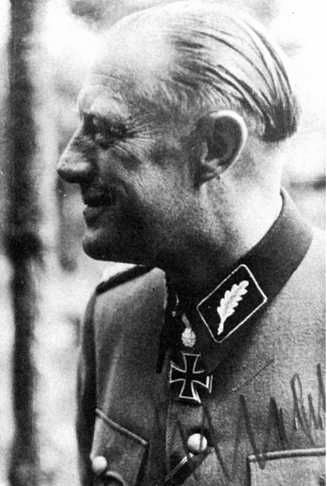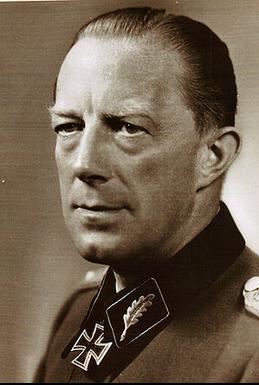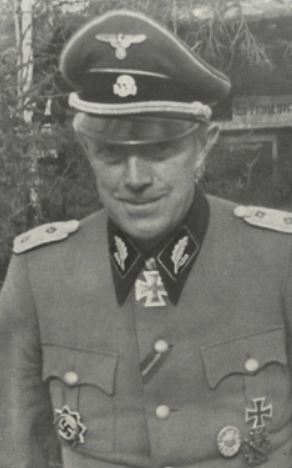Schuldt, Hinrich Rudolf (Waffen SS)
- Date of birth:
- June 14th, 1901 (Blankenese-Hamburg, Germany)
- Date of death:
- March 15th, 1944 (near Petschane, North of Nevel, Ostrov/Pskov Oblast, Riga, Russia)
- Buried on:
- German War Cemetery Riga Beberbeki
Grave: UNK. - Service number:
- SS-Nr.: 242.677 // NSDAP-Nr.: 975.664
- Nationality:
- German (1933-1945, Third Reich)
Biography
Promotions:
01.04.1922: Offiziersanwärter
00.09.1922: Seekadett
01.04.1924: Fähnrich zur See
01.04.1926: Oberfähnrich zur See
01.10.1926: Leutnant zur See
12.12.1933: SS-Sturmführer
11.06.1934: SS-Mann
10.01.1935: SS-Obersturmführer - RDA 01.01.1935
08.03.1935: SS-Hauptsturmführer - RDA 10.03.1935
09.11.1938: SS-Sturmbannführer
01.09.1941: SS-Obersturmbannführer der Waffen-SS
01.08.1942: SS-Standartenführer der Waffen-SS
24.12.1943: SS-Oberführer der Waffen-SS - RDA 09.11.1943
16.03.1944: SS-Brigadeführer und Generalmajor der Waffen-SS (posthumously with effect 14.03.1944)
Career:
01.04.1922: joined the Reichsmarine - Crew 22
00.04.1922-00.09.1922: Grundausbildung
00.09.1922: 2. Korporalschaft in Kiel-Holtenau
00.10.1922-00.03.1924: Bordausbildungen - SMS 'Braunschweig', 'Niobe' then 'Berlin'
00.00.1926: promoted to Leutnant zur See
00.00.1927: battleship SMS 'Elsass'
00.01.1928: left the Reichsmarine
00.00.1929-00.12.1933: Lt z.S., seemännisch-militärischer Lehrer, Hanseatische Yachtschule, Sierksdorf
01.12.1931: joined the NSDAP
01.02.1932: granted membership in the NSDAP
12.12.1933: SS-Sturmführer, Zugführer, 3. Sturm, SS-Standarte 'Adolf Hitler'
25.04.1934: joined the SS
00.00.1934: Stab, Chef des Ausbildungswesens der SA Friedrich Wilhelm Krüger
00.00.1935: SS-Ostuf, Ausbildungsreferent, Inspektion der Marinestürme der SA
00.02.1937-00.03.1937: SS-Hstuf, Chef, 1. Kompanie, Zugführer-Lehrgang, SS-Junkerschulen Tölz and Braunschweig in Dachau
00.00.1937--01.11.1938: SS-Hstuf, Chef, 3. Sturm, I. Sturmbann, LAH
00.10.1938: SS-Hstuf, campaign in the Sudetes, WIA and evacuated to Lazarett in Plauen
09.11.1938: SS-Stubaf, Stab, I. Sturmbann, SS-Standarte „Germania", Hamburg
00.06.1939: SS-Stubaf, Bataillonskommandant, SS-Standarte „Deutschland", München
00.09.1939: SS-Stubaf, Führer, ‚Kampfgruppe Schuldt‘, SS-Standarte ‚Deutschland‘, Panzer-Division 'Kempf' - campaign in Poland
00.11.1939: SS-Stubaf, SS-Regiment ‚Germania‘
01.01.1940-30.03.1940: SS-Stubaf, Führer, Polizei-Aufklärungs-Abteilung
01.04.1940-21.06.1941: SS-Stubaf, Führer, I. Sturmbann, SS-Totenkopf-Standarte 4 "Ostmark" - campaign in the West
05.07.1941-00.04.1942: SS-Stubaf, Führer, SS-Totenkopf-Standarte 4 "Ostmark"
15.07.1941: SS-Stubaf, Führer, I. Bataillon, SS-Infanterie-Regiment 5 - campaign in Russia
13.09.1941-20.04.1942: SS-Ostubaf, Kdr, SS-Infanterie-Regiment 4, Nordabschnitt
20.04.1942: unit renamed SS-Regiment „Langemarck"
07.08.1942-01.12.1942: SS-Staf, Kdr, SS-Regiment „Langemarck"
00.11.1942: SS-Regiment „Langemarck" sent to refit in Tessy, France
01.12.1942: SS-Staf, Kdr, SS-Brigade 'Schuldt' - Don-Front
23.02.1943-26.02.1943: WIA 2 times region Nikitowka-Bachtewitsch
00.03.1943: SS-Lazarett Berlin-Lichterfelde
11.05.1943: received the EIchenlaub by A. Hitler in Obersalzberg
01.09.1943: SS-Staf, Führer, 2. (lett.) SS-Freiwilligen-Brigade der Lettischen SS-Verbände - Peipus Lake, Ilmen Lake then Wolchow bridgehead
00.12.1943: SS-Ofu, Kdr, 2. Lettische SS-Freiwilligen-Brigade - unit renaming
07.01.1944-15.03.1944: SS-Ofu, Kdr, 19. Waffen-Grenadier-Division der SS (2. Lettische) - unit renaming, XXXVIII. Panzer-Korps
15.03.1944: SS-Ofu, severely WIA by an anti-tank direct hit near Petschane, North of Nevel and evacuated to a Lazarett in Riga where DOW
15.01.1945: 43. Waffen-Grenadier-Regiment der SS (lett. Nr. 2) named ‚Hinrich Schuldt‘
Do you have more information about this person? Inform us!
- Awarded on:
- 1937
- Period:
- Second World War (1939-1945)
- Awarded on:
- October 24th, 1939
- Period:
- Second World War (1939-1945)
- Period:
- Second World War (1939-1945)
- Awarded on:
- October 1941
- Period:
- Second World War (1939-1945)
- Awarded on:
- 1941
- Period:
- Second World War (1939-1945)
- Rank:
- SS-Obersturmbannführer (Lieutenant-colonel)
- Unit:
- Kommandeur, SS-Infanterie-Regiment 4 "Reichsführer-SS", 17. Infanterie-Division, XII. Armee-Korps, 4. Armee, Heeresgruppe Mitte
- Awarded on:
- April 5th, 1942
1) The rapid seizure of a vital piece of high ground near Schopina. This objective had been suggested by XXXXIII. Armee-Korps, but not ordered due to Schuldt's own weak forces. He nonetheless recognized a favourable situation and was able to capture the place even so. In doing this he created a flank guard for the Army, which forced the enemy to delay his encirclement of the Kaluga position for several days.
2) Creating the preconditions for the closure of the gap that had formed north of 4. Panzerarmee, and later covering the flank of the unit (17. Infanterie-Division) that was assigned for carrying out this task. The closure of this gap proved to be of vital importance to the whole Heeresgruppe.
949th Award.
- Period:
- Second World War (1939-1945)
- Awarded on:
- August 1942
- Period:
- Second World War (1939-1945)
- Awarded on:
- February 1943
- Period:
- Second World War (1939-1945)
- Rank:
- SS-Standartenführer (Colonel)
- Unit:
- Kommandeur, SS-Brigade 'Schuldt', XXIX. Armee-Korps, Heeresgruppe Süd
- Awarded on:
- April 2nd, 1943
"On 19.12.1942 SS-Standartenführer Schuldt with three Leibstandarte Kompanies and one-and-a-half Kompanies from the SS-Polizei Division were moving in the billeting area assigned by the XXIX. Armeekorps in Meschkoff. On the way they met the Italians from Armeeoberkommando 8 falling back and rushing in disorder, closely pursued by the Russians. In a quick and bold resolution. SS-Standartenführer Schuldt switched over from the march to counter attack and took the high ground east and north east of Meschkoff that dominated the entire area. The Russians were thrown back in the whole area and the high ground held. Then a report about the failure of the Italian defensive front was sent to the XXIX. Armeekorps (this was the first report that the German Command received about the collapse of the Italian Front).
Schuldt displayed a clear and widespread knowledge of the tactical situation. Due to the resolute and energetic leadership of the commander and the bravery of his SS men, the majority of the Italian troops could be saved from being completely annihilated.
Under the personal leadership of Schuldt, the positions in Meschkoff were held against strong enemy infantry and tank attacks. Meanwhile two Russian Tank Corps broke through the left flanking unit towards the west and in the course of the following day completely encircled the XXIX. Armeekorps. The entire XXIX. Armeekorps staff with the Korps commander, straggling German troops and Italian units in disorder all found themselves in the cauldron. They were harassed by the tanks of the attacking opponent from all sides. The only significant combat power at hand was in the elements of SS-Kampfgruppe Schuldt . Again it must be credited to the energetic and precise leadership of the Brigade commander that, after hard fighting, the breakout of the Armeekorps to reach the lines of Heeresgruppe Don on 29.12.1942 could be successful.
On 15.01.1943, in spite of the strongest defense, parts of the SS-Brigade 'Schuldt' were surrounded at the bridgehead and blocking positions near Nowo-Jerochin and Klitwenezkaja. The order of the XXX. Armeekorps to disengage and fall back to Kamensk did not reach the Kampfgruppe because the radio station was destroyed by a direct hit. In that moment, when the position in Nowo-Jerochin was almost completely surrounded by 15 Russian tanks, the vigorous leadership of SS-Standartenführer Schuldt was proven again. He ordered that all the forces engaged in Nowo-Jerochin should break out towards Kamensk. Schuldt, with a small group of SS men and officers attracted the attention of the enemy to facilitate the escape of our troops. The next morning the commander with one officer and five men finally reached Kamensk, after having gone through the Russian formations already deployed in front of Kamensk.
In the night from 31.01. to 01.02.1943 the enemy attacked SS-Brigade 'Schuldt' by surprise with strong forces reinforced with tanks. The area became our defensive front over the Donez. In an extremely hard and bloody fight the positions in Woroschilow and Shiroky were held for two days and two nights. They thwarted a complete breakthrough of the opponent that severely hit the Brigade's defensive positions, which had the end goal of reaching Krassnodon. This success must be credited to the energetic and lively leadership of the commander and his personal performance.
After the withdrawal of the defensive front to the Wodjanoj position, it was only thanks to the compelling personality of the commander, often by force, that the newly attached elements of the 304th Infantry Division held back the enemy. He forced them to build up their positions so that the massive attacks of the opponent were resisted until the order to withdraw was given. The opponent recognized the Brigade's hard defensive willpower and, with the support of tank forces, tried repeatedly to force a breakthrough either by the right or the left flank. That put the Brigade in extreme danger and in a serious situation. Only through the bravery of the Brigade and attached units under the energetic and prudent leadership of its' commander could the situation be stabilized. In this period. the Brigade destroyed 24 tanks and three armoured attack airplanes of the enemy.
To finish off a local enemy break-in to the west of the Olchowaja sector, SS-Brigade 'Schuldt' was transferred on 22.02.1943 into the area of Nikitowka-Bachtewitsch. On 23.02, after moving into the assembly position, they attacked the opponent in Wassjukowa-Schl. with an assault group under the command of the SS-Sturmbannführer Dietrich. They had the objective of enabling the recapture of the main fighting line by Gruppe 'Hunten'. With the attack progressing, the battle developed more and more into close combat by assault detachments at short range. After a hard fight under the personal leadership of the Brigade commander, who in the course of the battle was wounded by a shell splinter above the right eye, the old main fighting line could be reached and occupied.
In the meantime, on 24.02.1943, the Russians managed to penetrate the left flank of Gruppe 'Hunten' with strong forces. At that moment, when the whole defensive front in the right sector of Gruppe 'Kreysing' threatened to collapse, this sector was subordinated to SS-Brigade 'Schuldt' with the following words of General Kreysing, "Herr Schuldt, you must do it, I rely on you." The commander of the Brigade, SS-Standartenführer Schuldt, recognized quickly that hills 287.4 and 227.4 were essential for the defense and also as a rallying point for any counterattack. They had to be held at any price. Schuldt's energy, which he stressed to the officers subordinated to him and at the same time was passed along to all of the fighting troops, must be thanked. The heights were again snatched away from the opponent in a surprise counterthrust, and with this the impending breakthrough could be halted as well.
After a very hard initial battle, on 26.02.1943, a counterattack (again under the personal leadership of the commander) destroyed the massive enemy forces in the Ssereschina-Schl. in two-and-a-half hours. The day's objective and with it the old main fighting line were reached. During the attack the Commander was wounded for the second time by mortar splinters in the shoulder and back. After that time the assignment of the Kampfgruppe was fulfilled and the disengagement of the Brigade began."
220th Award - based on a recommendation dated 10.03.1943 and signed by the Brigade Ia, SS-Hauptsturmfuhrer Carl-Günther Molt; personally presented by Adolf Hitler on 16.04.1943 at the Reichskanzlei, Berlin
- Period:
- Second World War (1939-1945)
- Rank:
- SS-Standartenführer (Colonel)
- Unit:
- Kdr, SS-Brigade 'Schuldt'
- Awarded on:
- April 21st, 1943
Award 363/2.
- Period:
- Second World War (1939-1945)
- Rank:
- SS-Oberführer (Brigade General)
- Unit:
- Kdr, 2. Lettische SS-Freiwilligen-Brigade
- Awarded on:
- February 29th, 1944
- Period:
- Second World War (1939-1945)
- Rank:
- SS-Oberführer (Brigade General)
- Unit:
- Kommandeur, 2. "lettische" SS-Freiwilligen-Brigade
- Awarded on:
- March 25th, 1944
"Oakleaves holder SS-Oberführer Schuldt has activated and trained the 2. Latvian Volunteer Brigade in the Wolchow bridgehead under the most difficult conditions. The fact he managed to build a combat unit capable of the highest performance in mobile warfare from mostly untrained Latvian volunteers in a dangerous, swampy land in only a few months is due to his organizational talent, high military knowledge and unequalled energy. The brigade is result of his work.
In mid-January the Russians, with far superior forces, forced back the right adjacent division. The break-in from Podbereshje threatened to widen to a full break-through. SS-Oberführer Schuldt, recognizing clearly the extreme seriousness of the situation, decided to hit the enemy—which was moving west—with a severe blow in the flank. He inflicted heavy losses on the Russian assault divisions and gained at least forty-eight hours of decisive significance for the battle command of the Korps and for the operations of the Army. The road Kampfgruppe Schuldt kept open allowed an Armeekorps with five subordinate divisions to pull back.
To achieve the highest possible concentration of forces for the active defense, SS-Oberführer Schuldt removed men from his line not attacked initially by Spaskaja Powistj so that in every Kompanie sector one NCO and two to four men simulated a complete garrison through noise and movement. This was done although the idea of a strong enemy thrust against this sector seemed completely possible.
He gave the order for the retreat of his southern wing that was threatened in the deep flank. This was done only after he accomplished, with the minimal forces available and great difficulty, the recovery of the last stationary positioned weapons.
When the advance of the newly committed Russian divisions on the road Raglizy-Sselo-Gorka towards the west was no ionger preventable with diminishing forces, SS-Oberführer Schuldt proposed letting himself become encircled with his Kampfgruppe. He wanted to cause the highest possible damage to the enemy, who was attacking from all sides, and then break through.
That this decisive success could be achieved—and Kampfgruppe Schuldt in the ensuing bitter and heavy retreat battles with its left flank almost always open against strong Partisan troops in the rear was successful—is due to SS-Oberführer Schuldt. He reached his objective in strict order and must be thanked. Besides the bravery and hardness of the Latvian volunteers, Schuldt's outstanding personal bravery, power of decision, superior calmness, and almost unique energy is to be credited.
SS-Oberführer Schuldt, who was killed on 15.03.1944 amongst his grenadiers, whose name far beyond his unit has served as a standard for the success of even the heaviest and seemingly meaningless undertakings, is considered especially worthy of being awarded the Swords to the Oakleaves of the Knight's Cross of the Iron Cross."
56th Award.
Awarded posthumous - based on a recommendation submitted by General der Artillerie Kurt Herzog, Kom. Gen. XXXVIII.Panzer-Korps; endorsed by Generalfeldmarschall Walter Model and approved by Reichsführer-SS Heinrich Himmler on 20.03.1944
Sources
- Photo 1: Public Domain
- Photo 2:
- Photo 3:
- - MOONEY, PETER, Waffen-SS Knights and their Battles, Schiffer Military History, 2016.
- MOONEY, PETER, Waffen-SS Knights and their Battles, Schiffer Publishing, Ltd., 2012.
- THOMAS, FRANZ & WEGMANN, GÜNTER, Die Eichenlaubträger 1940-1945, Biblio-Verlag, 1998.
- Die Ordensträger der Deutschen Wehrmacht (CD), VMD-Verlag GmbH, Osnabrück, 2002
- Kwasny A., Kwasny G., Die Eichenlaubträger 1940-1945 (CD), Deutsches Wehrkundearchiv, Lage-Waddenhausen, 2001
- Fellgiebel W.P., Elite of the Third Reich, The recipients of the Knight's Cross of the Iron Cross 1939-1945: A Reference, Helion & Company Limited, Solihull, 2003, ISBN 1-874622-46-9
- Patzwall K., Scherzer V., Das Deutsche Kreuz 1941-1945, Geschichte und Inhaber Band II, Verlag Klaus D. Patzwall, Norderstedt, 2001, ISBN 3-931533-45-X
- Axis History Biographical Research via Axis History Forum





























